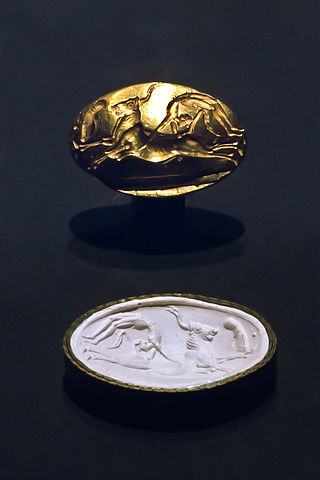- Minoan seal-stones
-
Minoan seal-stones are gemstones, or near-gem-quality stones produced in the Minoan civilization. They were found in quantity at specific sites, for example the Citadel of Mycenae.
Minoan seal-stones are of a small size, 'pocket-size', in the manner of a personal amulet. They might be thought of as equivalent to the pocket-sized, 1 inch (3 cm) scaraboid seals of Ancient Egypt. However Minoan seals can be larger, with largest examples of many inches.
Topics of the seal-stones
The topics of the seal-stones centers on the Minoan civilization, with animals, dance, goddesses, etc. One common iconographic art theme in Minoan art, especially frescoes, was bull-leaping; the example seal-stone shows leapers and a bull. Other themes are varied, including for example: 'pottery and a plant'-(with 5 moon/planet crescents), 'confronted-goats', and a 'single bird'.[1]
References
- ^ The March of Archaeology, pg. 63.
- Ceram, C.W. The March of Archaeology, C.W.Ceram, translated from the German, Richard and Clara Winston, (Alfred A. Knopf, New York), c 1958.
-
museum examples—impressions
(stamp seals also shown)
This article relating to archaeology in the Near East is a stub. You can help Wikipedia by expanding it.



